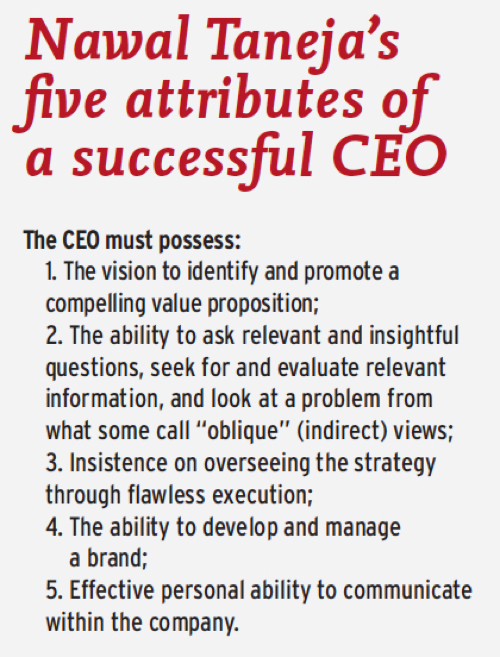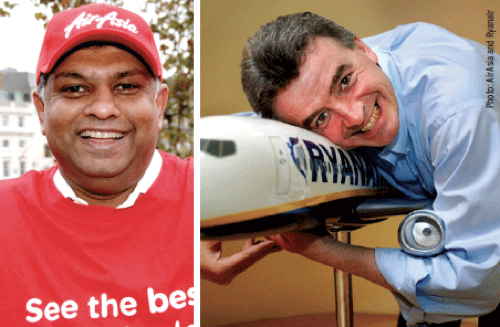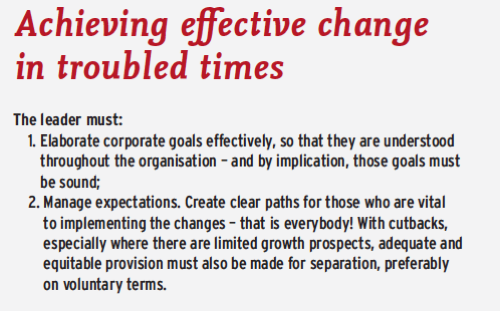Finding the ideal airline CEO for our times
CAPA's analysis finds the ideal airline CEO focusses on the "People Priority", but that confrontation in today's industrial scene may shift attitudes towards a harder line.
This report appears in the Dec '11 - Jan '12 edition of Airline Leader, the strategy journal for airline CEOs. The full edition is available for download from airlineleader.com
These can be troubled and confusing times for beleaguered legacy airline managements and their workforces. Inertia, always the most powerful force, is not however a long-term option in an industry that is currently being turned on its head. As the competitive pressures grow, so it seems does the intransigence of employees and their unions. Strains of the "Occupy Wall Street" protests can be heard in this evolution, implying that the successful airline CEO's profile must in future be even more focussed on relating to human relationships within the company. For new entrants and the high-speed growth markets of Asia, the Middle East and Latin America, innovation is more conspicuous.
"Today we lost one of the most influential thinkers, creators and entrepreneurs of all time. Steve Jobs was simply the greatest CEO of his time." - Rupert Murdoch, Oct-2011
Few would disagree with Rupert Murdoch's above statement on the former leader of Apple. Steve Jobs could see around corners. He eschewed traditional market research - imagine asking a focus group 15 years ago if they would like an iPod, with all the accompanying issues of access to copyright music. He changed the way the world listened to music and viewed media. He was not always first to the point, but his result was always markedly better and his marketing flawless. With Mr Jobs went epithets such as relentless, visionary, creative genius, inspirational, revolutionary - along with perseverance and stamina.
In a changing world, Steve Jobs touched billions of people's lives. He actually played a role in changing it. Technologically he was a great, yet his biggest strengths were promotion and product delivery. Together these comprised an unbeatable combination.
But he could only achieve what he did with near-unfettered power to implement what he fiercely believed was right. And he was relentless in pursuing his goals.
Certainly under his leadership Apple's share price soared. Do these attributes qualify him to be considered the "the greatest CEO of all time"?
He had undoubted brushes with morality in some of his dealings; he was frequently brutal in his relations, with competitors, partners and staff alike.
And finally, he was considered irreplaceable. Partly because he was one of a kind, but does the perfect CEO leave a massive hole when he leaves? Ideally not - and perhaps he has not; we have yet to see. And could Steve Jobs have been a great airline CEO?
Defining the ideal airline CEO
This report will seek to address specifically what characteristics go into making a great airline CEO. As Nawal Taneja notes in this month's opinion column, (of Airline Leader) the quest for the secret is a well-trodden path. But there are specific features that confront an airline leader over and above the common elements of corporate leadership. This was never truer, as an entire industry experiences upheaval.
Despite the airline industry boasting many more high profile brands globally than any other area of commercial activity, very few CEOs force themselves forward as outstanding leaders. Some of the reasons for this may emerge below.
One current leader who has undoubtedly been successful in generating profitability is Michael O'Leary, CEO of the European LCC, Ryanair. Yet he is abrasive publicly, has a relatively high turnover of management (although junior staff tend to have greater longevity) and can hardly be said to have sympathetic people skills. Mr O'Leary could not be further removed from the progenitors of the model his airline emulates - Southwest Airlines.
Herb Kelleher (at first with Lamar Muse and later supported by Colleen Barrett) would be most people's pick as the best airline CEO of all time. He was inspirational, innovative, constantly generated profits and, above all, established a remarkable culture in the granddaddy of all LCCs. Moreover, the culture was institutionalised, so that it survived into the next generation of leadership.
One is a tank battalion commander, the other a skilled conductor of a complex human machine. In each case shareholders saw enormous capital gains and rapid airline growth, but other outcomes could not have been much more at odds.
Airline CEO leadership styles have varied from abrasive commander to conductor of a complex human machine

This ideal CEO is not going to be easy to find - and many features conspire to make the airline business different. That statement will offend many management experts; certainly every business is different. But airlines are more different! There are many layers to the airline onion. One anecdote, a useful test of the complexity of any business: experienced corporate litigation counsel are generally extremely quick to pick up the complexities of any business they confront, often several in the course of a single day. Asked to act in an anti-competitive airline pricing matter, the counsel concerned came to a Monday briefing armed with two hours to learn the niceties of airline costing and pricing. By the end of a week, they had started to feel they understood the process.
An airline is many businesses under a single roof (and many roofs globally). The day-to-day issues involved in aircraft maintenance, catering, running a frequent flyer programme, distributing product through multiple channels, handling bags and freight, training, managing and retaining skilled staff such as pilots, making risky multi-billion dollar investments in future aircraft, hedging currencies and fuel prices, with costs and revenues (and staff) spread through perhaps 60 nations and dealing with a host of different industry partners - could hardly bring with them a wider range of challenges. That is even before navigating the mountainous daily log of regulatory matters, in an industry where safety is the often unspoken fixed reference point and arcane economic constraints apply. Government is ever-present in an airline CEO's vision.
There is another distinguishing feature: the airline industry is a very old business, which boasts vastly more sexagenarian companies than any other. Several well known brands are well into their 80s and beyond. KLM, Avianca and Qantas are all well into their tenth decade and Mexicana just fell short, at the age of 89, when it finally collapsed in 2010. That this longevity is a child of regulation is no secret. As with the fragile human body, age frequently brings with it sclerosis. In industry terms these are known as legacy issues. They embrace pension funds, older, more costly employees and, above all, numerous highly organised and often globally coordinated unions. With a dozen or so unions to negotiate with, personnel issues are never far from front of mind for an airline CEO, for better or for worse.
Then there is the half-pregnant nature of the industry, part economically regulated, part not. It is fiercely competitive, yet nationalistic hangovers preclude international mergers. The result: the global industry almost never returns its cost of capital. It is consistently the worst performing industry, bar none. It only exists because its constituent airlines tend to pay their debts. Equity is not the foundation. No intelligent investor sees airlines as a long-term place to park funds. They are simply too complicated. Stock prices rarely even cover the asset value of an airline.
This has given rise to the occasional attempt to privatise an airline company in order to expose and sell down the profitable parts, such as frequent flyer programmes, the rentable value of the fleet and various other functions such as catering and maintenance. In this way, the thinking goes, the simplified company structure allows better value assessments by analysts - and each company with its own CEO. Where it has happened however, with Air Canada for example, the residual airline struggles to make a living, because it is intrinsically such a poor business.
Thus airlines essentially exist to support a host of suppliers and financiers - as well as to perform a remarkable socio-economic function. The industry drives world tourism and in doing so ensures it is always in the spotlight, among consumers and politicians alike. If a politician wants to get some quick media coverage, attacking the airlines is guaranteed to get front-page column space.
Who then in their right senses would want to run an airline? The airline CEO's remuneration, while rarely at similarly high levels to heads of simpler, much less competitively-threatened and inconspicuous businesses, is typically not outstanding. A popular answer is that it is the buzz, the profile it attracts - "there is never a dull moment" - like moths to the flame.
The three Ps of leadership: people, processes and profits
The relative importance of these leadership ingredients is largely a matter of opinion (and timing), although there is one clear prerequisite: to remain in business, to be profitable. Without it no others can exist.
But it also important to recognise the importance of each will vary depending on timing, the airline involved, and its competitive positioning. Right now, one of the commonest stories for legacy airline management is how to adjust - quickly - to change. Paradoxically, that applies to both the rapid growth and the stagnant market airlines. The direct implications for the priority among the Ps is that people must come first; whether or not it is respected in the day-to-day running of a company, that's why most airline CEOs today stress it is their people who are their main asset - the sine qua non.
The 'People Priority'
This old industry is in transition. The process has been accelerating over the past two decades, but the reality of a new world is now unavoidable, as global economic conditions decline and growth in mature markets is no longer there to paper over the cracks that appear. Short-haul routes are under attack by low-cost competition; long-haul is becoming more competitive as regulatory controls are lifted and new entry from Middle Eastern and Asian airlines is introduced.
In these conditions, a common pattern of heavy bargaining is evolving. Legacy airline managements are being forced to make big strategic adjustments, and to do so in short order. Their primary action is inevitably to reduce costs. Yet most costs are external and allow only limited management options; fuel, now more than a third of cost, capital expenses and other overheads are inflexible, at least in a timeframe that allows suitable responses to new competitive challenges.
Manpower reductions and productivity enhancements therefore become almost the only levers to pull. But despite often-inefficient work practices and relatively highly paid staff, the unionised segments are understandably unwilling to concede to change. Indeed, where the airlines have become profitable - partly due to cutbacks on pay and headcount - wage increase demands are becoming more frequent. Often, even where employees recognise the pressures on the airline, taking action in the common good becomes unacceptable at an individual level. Here the push-back occurs and so management skills need to focus more on the People Priority.
The People Priority is not a switch that can simply be turned on or off. It is a core part of a management's culture and generally takes time to develop - and it must be nurtured. One right move can sway opposition, just as one wrong step can unravel years of hard work. So, not only must several people-oriented courses of action be committed to, there must also be the management capability to apply them consistently.
In some - very rare - cases, a leader can create a strong culture over a short period of time by his (or her) actions and through genuine leadership. It is that character who is arguably most in demand in today's heated industrial conditions. And even where an individual can make that change, paradoxically, it will not be achieved in isolation; he or she will be the one who is able to carry the board and staff along on the weight of strategic commonsense and an ability to communicate on a multilateral scale.
This valuable leader must be able to formulate and articulate corporate goals that all staff can recognise. Especially in a highly unionised environment, managing staff expectations is key to this process, ensuring they believe in it and feel some ownership. At the same time, customers too need to be able to relate to the innovations being made.
The People Priority is also important in external dealings, in partnerships. Thanks to the arcane regulatory system within which international airlines have to work, any thought of, for example, a hostile multinational takeover of, or merger with, a competitor never crosses the airline leader's mind. Instead, partnerships can be the make-or-break of an airline's prospects. A minority equity share is the best that can be hoped for. So the ability to secure and nurture partnerships with other carriers is increasingly important as the industry liberalises, while having its feet still anchored in the cement of national ownership requirements. The "poor man's merger", or alliance, therefore assumes ever-higher priority. Today these are not optional relationships - they are an essential extension of market reach.
Whether it is in a global alliance or in a series of bilateral links (often both), the CEO is focal. In bilateral relationships especially, good personal chemistry, as well as the necessary strategic synchrony, is a precondition to success.
The implied hands-on nature of this person-to-person ideal does, however, involve drawing a fine line between leading from the front and being so engaged that the high level goal-making becomes blurred. The complexities in drawing together numerous different businesses can easily force the CEO into becoming predominantly an operating officer rather than an executive - a chief operating officer, not a CEO. The CEO can all too easily become much more operationally focused than his equivalent in any other company. That has some positives - it ensures a full grasp of all the interactions within the airline, for example, and it allows a good personal-touch CEO who is seen to be managing difficult problems, entrenching hero-relationships in the process.
But it can also mean that everything that goes wrong is directly personally sheeted back to the CEO, regardless of actual accountability.
The anti-hero with a big impact: Frank Lorenzo
No airline leader is more frequently referred to as the anti-ideal CEO than Frank Lorenzo. Even beneath the hype, his union-busting can be credited with terminating at least one US carrier, venerable Eastern Airlines. Time Magazine named him one of the 10 "worst bosses of the (20th) century". His approach to management was essentially as a corporate raider, with a highly confrontationalist attitude towards organised labour. In these respects Mr Lorenzo perhaps provides the foil against which the ideal CEO can be measured.
Yet his legacy was not all bad. Part of it was taking a then-shaky Continental Airlines into Chapter 11 bankruptcy in 1983, revoking all union agreements, reducing staff by a third and halving pilots' salaries. The "New Continental", by now profitable, emerged from bankruptcy in 1986, paying creditors 100 cents in the dollar, but with a much more competitive cost profile. At that time, the airlines controlled by Mr Lorenzo's Texas Air group comprised a fifth of the entire US industry. Recently merged into United, Continental is, paradoxically, led by Jeff Smisek, generally recognised as having created one of the best legacy airline cultures in the US - despite being a lawyer and financier.

Balancing risk management with innovation
Airlines are typically institutionally weak in risk management. This may seem odd for an industry that is so risk prone. Despite - or perhaps because of - the wide array of uncontrollable external hazards in particular, risk minimisation and management is typically distributed across a variety of corporate areas. The constant ones, such as fuel prices and currency management, will typically be the responsibility of the treasury, whereas management of "unanticipated" events such as terrorist attacks, volcanoes and ash clouds, pandemics, accidents, government tax impositions, union actions and any one of numerous events with a potentially serious impact on the bottom line, are dealt with across a number of "silos".
Each event may be out of the ordinary, but their common theme is that one or other occurs with almost clockwork regularity - a phenomenon that CAPA branded "the Constant Shock Syndrome" at a time when SARS almost grounded several major Asian airlines in 2003. And that came shortly after several terrorist attacks, including those on New York's Twin Towers.
This institutional incoherence therefore forces the airline CEO to become involved in almost every aspect of managing the fallout from each event. So the constant diversions into managing risk undermine the ability to manage creatively; he is massively distracted from seeing the big picture.
The other side of hands-on risk management is innovation - or often, lack of it, in most airline managers of recent years. Steve Jobs was always striving to innovate. He was a master of technology and had the luxury of being hands-on in developing new models in an area where rapid advances made innovation de rigeur. His was a young industry, overthrowing the longstanding powers of music distribution and communications. Without innovation, Apple was dead.
The same is hardly the case for network airlines. Here the status quo can be charmingly - and deceptively - attractive.
In this situation the airline CEO is typically hemmed in by such an array of unfriendly external events and myriad suppliers (including airports, employee unions, government regulators, debt providers and lessors, even apart from the host of other service and equipment providers) that conservatism rules. Taking a low-risk approach is so attractive that it becomes almost irresistible.
Like the Sirens in Homer's Odyssey, the beautiful voices of the regulatory status quo can unfailingly lure management onto the rocks in today's new world. Throughout the modern history of aviation, economic regulation has distorted the nature of the airline business, so it is perhaps only normal that reliance on government intervention becomes the refuge of last resort. But to use it actively to stifle innovation by others or as an excuse for inaction cannot be a sustainable strategy. It is simply instead a means of delaying - and encouraging - the inevitable.
The lure of the status quo can be as compelling as the Sirens's voices in Homer's Odyssey

As the late Peter Drucker, widely considered the father of modern management, observed: change provides the opportunity for innovation. He also urged that the process be systematised. Unless there is a system in place, the default position too easily becomes resistance to change, not innovation. Few industries are undergoing more change than airlines, yet the opportunities to innovate are seemingly going begging, notably among the longer established incumbents. The result can be that any thought of systematising innovation is excluded by a fear of change in the first place.
The new entrant airline, by contrast, has all to gain and nothing of the status quo to lose. Innovation is a prerequisite, even if it means slavishly following the basic principles of an LCC. This often requires people skills, such as those so well illustrated by Tony Fernandes, AirAsia CEO, whose people skills extended well beyond internal inspiration, through to being able to establish new forms of cross-border partnerships and even most recently to acquiring a substantial minority share in the Malaysian flag carrier, Malaysia Airlines, his original major competitor. Contrast again though the Michael O'Leary style, which pays little heed to such personal skills.
AirAsia's Tony Fernandes and Ryanair's Michael O'Leary head up highly successful airlines,
but have contrasting approaches to leadership

The skilled leader, however, will also probably be forced to guide his company through a process of evolution, as external conditions change. Recent, apparently successful, examples of this include: Virgin Australia's adaptation to a full service airline through various phases, Air New Zealand's re-creation as a full service airline but with many of the personal attributes of an LCC and Aer Lingus' metamorphosis in the face of fierce competition from Ryanair and others.
And here, to return to the heavy burden on the airline CEO-cum-COO, Peter Drucker emphasised that the top manager cannot afford to be bogged down in day-to-day operations: "purposeful abandonment" is a precursor to innovation. Too often today, the CEO must be involved not only in the thought processes but also the execution of too many functions. Innovation can get out of reach.
While European legacies have been leveraging ownership structures and driving alliances, US full service airline CEOs have typically ranked among the low-risk takers. That is not necessarily a criticism, although it can scarcely be a compliment, given the overall performance of the sector over the past 20 years. During that time the US majors have been characterised by a barely indistinguishable chorus of bankruptcy - almost as a strategy - consolidation and partnerships. Non-LCC capacity growth since 2000 has been negligible and all of the service and operating initiatives, even including such simple but vital revenue earners as charging for bags, have been borrowed from new entrants. Innovation has been conspicuous by its absence.
The new entrants, by contrast, have been responsible for delivering improved service quality, such as JetBlue and Virgin America, or easyJet in Europe, along with numerous initiatives around reservations and distribution and passenger facilitation. Not all of them survived, but they certainly have the advantage of starting with a blank page, a good place to start when innovating, but there is no reason they should have had to show legacy airlines the way in such areas as baggage charges!
In a class alone is of course Southwest. Herb Kelleher guided the US industry's black sheep superbly through literally decades of profitability, arguably leaving at a very propitious time. During the first decade of this century, LCCs were overlapping significantly and Southwest was inevitably showing some signs of legacy weakness. But the airline is still distinguished by the positive inheritance he and former executive vice president Colleen Barrett left, with a culture that is preserved institutionally.
Herb Kelleher was undoubtedly hands-on, as are the small, new, passionate entrepreneur-led airline CEOs. This leader sees things first hand, feels the wind. The established airline's CEO is meanwhile easily installed in a comfort zone of boardrooms, big business colleagues, a corner office on the 42nd floor, chauffeured cars, lunches in the boardroom (never in the staff canteen) and surrounded by minders. No different from many other CEOs, but the successful airline leaders realise they need to be in touch.
Southwest co-founder Herb Kelleher with former executive vice president Colleen Barrett,
both of whom were responsible for institutionalising a positive working culture

As Peter Drucker said, the comfort zone CEO consequently sees the outside world through distorted lenses, with little first hand knowledge of what is happening. Everything is seen through an "organisational filter". This is a dangerous place to be when the world around is changing so fast.
It is possible - if not inevitable - that a division between CEO skill profiles will exist in different parts of the world. For example, in the more hierarchically oriented cultures of Japan and Korea, the approachable CEO may be valued less. Leadership is still highly valued, but takes different forms. Yet even this stereotypical leader is fast disappearing as generational power shifts occur.
This is, for example, particularly evident in new low-cost start-ups, which tend to target the younger, increasingly affluent singles market. Korean Air's low-cost subsidiary is called Jin Air. Its flight attendants wear t-shirts and jeans ("jins") expressly to appeal to a different segment.
Asia and the other high-speed economies of the Middle East, Latin America and Eastern Europe (as well as Africa) are home to vibrant, expansive airline markets. They can be intensely competitive, but they are redolent with opportunity. Innovation does not come automatically in these circumstances. The Asian flag carriers mostly derive from a recent history of government ownership and protection, so taking potentially risky - for the CEO - new moves is far from instinctive. Yet the fast expanding Asian markets are spawning new entrant LCCs that in turn provoke responses from the various flag carriers. As the LCCs establish across national borders using a uniquely Asia Pacific/Middle East joint venture formula - so that no less than 14 full service airlines across these zones now have their own low-cost subsidiary of one kind or another, in several cases, more than one - complex management skills become more valuable.
Managing potentially conflicting goals of the different airline subsidiaries was something the US and European companies found too hard in the late 1990s; today the formulae are different, supported perhaps by less rigid work practices and the potential for growth (as opposed to substitution) that encourages successful solutions.
What Peter Drucker says about natural leaders
Management guru Peter Drucker believed natural leaders are born, not made. But the wrong management can stifle leadership. That is, the right conditions have to exist for even the real natural leaders to prosper.
Natural leaders:
- Ask themselves what the organisation requires of them to contribute effectively;
- Ask the right question, rather than finding the right answer;
- Take control when things get tough - not just hold more meetings;
- Recognise that company morale and culture are their personal responsibility;
- Know what not to do - knowing how to prioritise is vital.
Identifying a CEO's most important attributes varies with place and time
The airline industry has reached a watershed as reduced international market entry barriers, new technology, new entrants (short- and long-haul) and increasing signs of legacy sclerosis emerge. Increasingly too it appears that we may be at a turning point - or at least an intensifying battleground - as employee and union preparedness to make further concessions evaporates.
For the growth markets, the simple fact of market expansion provides an escape valve; keeping staff contented is a lot easier when the organisation is growing. Employee desperation does not exist in expanding markets. There is also plenty of room for management innovation.
But where markets are stagnating and new entrants are challenging the status quo, expansion is difficult and costs come under greater pressure - ideal conditions for disharmony and union unrest. In some cases a belief is emerging that there is nothing left to lose; there can be nothing more dangerous than a cornered beast with few options but to tough it out.
Here is where the great CEO's human talents are most appreciated. Innovation as a goal may appear a lot more remote, but keeping the workforce onside and informed of company goals is central. The human element takes on a priority like never before, because, without the corporate will to restructure and adjust, the other two Ps - profits and processes - simply cannot be achieved.

So, faced with today's two-speed global growth pattern, defining the ingredients of CEO leadership must vary according to time and place. One CEO hat cannot fit all.
The very fact that there are so few examples of enlightened leadership in the airline industry suggests there is a preference for conservatism in management, rather than risk taking with new opportunities - and that in turn raises the question of which is the wise direction to take. If everyone else does it, it becomes the safest option - or so this thinking rolls out. However, history does not offer a great deal of comfort; most airlines have performed poorly, essentially imitating their competitors and under-achieving.
This perhaps belongs to a way of management thinking that prefers benchmarking against other airlines - as opposed to against other companies generally. The Kellehers and Fernandes' of the business never did that, breaching the conservative barriers that confined all others. Not everyone can easily think outside the square of airline introspection, least of all large incumbent flag carrier leaders.
Postscript
There is an alternative scenario. Faced with extended unfavourable economic conditions and the threat of a zero-sum marketplace where new entry is eroding market share and profits, attitudes can quickly harden. The default position for boards and senior management in times of stress is usually to revert to conservatism and old ways. In this event, the potentially successful CEO - supported by the company's board - may take a confrontational approach, the "crash-through-or-crash" strategy. Where intransigence exists in the bargaining process, this can be an attractive option. These are different times. But does that serve long-term goals?
What do you think?
Airline Leader acknowledges and thanks the following for their advice, suggestions and ideas:
Paul Mifsud; Vaughn Cordle; Trung Ngo; Nawal Taneja; Torbjorn Karlsson; Herb Kelleher; Rob Fyfe; Peter Drucker.